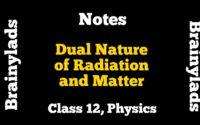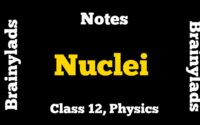Atoms Class 12 Notes | Term 2 | Physics |
Table of Contents
Atoms Class 12 Notes, Term 2, Physics
Atoms
All elements consists of very small invisible particles, called atom. Every atom is a sphere of radius of the order of 10-10 m, in which entire mass is uniformly distributed and negative charged electrons revolve around the nucleus.
Experimental arrangement for α-scattering experiment and trajectory followed by α -particles
Impact parameter perpendicular distance of the velocity vector of a-particle from the central line of the nucleus of the atom is called impact parameter (b).
where, K is KE of α-particle, θ is scattering angle, Z is atomic number of the nucleus and e is charge of nucleus.
Basic assumption of Rutherford’s atomic model
(i) Atom consists of small central core, called atomic nucleus in which whole mass and positive charge is assumed to be concentrated.
(ii) The size of nucleus is much smaller than the size of the atom.
(i) Could not explained stability of atom clearly.
(ii) Unable to explain line spectrum.
BOHR’S MODEL OF HYDROGEN ATOM
- Drawbacks of Rutherford’s atomic model lead to the Bohr’s Model where he came up with 3 postulates:
- First Postulate : Atoms have some specific stable energy states(called stationary states) where electrons could orbit around the nucleus without emitting radiation
- Second Postulate: Orbiting of electrons occur only in the orbits (called stable orbits) where electrons’ angular momentum(L) is equal to the integral multiples ofh/(2π), leading to the quantization of moving electron
LN =MVNRN = NH/(2Π)
Here h= Planck’s constant = 6.6×10-34Js
Ln= angular momentum of electron in nth orbit
vn= velocity of electron in nth orbit
rn= radius of nth orbit
n= permitted orbits on which electron revolve (called principle quantum number)
- Third Postulate: Electron while jumping from higher(initial) energy state to lower(final) energy state, emit a photon of energy equal to the energy difference between the 2 energy states, and its frequency is given by:
hv = Ei – Ef
Bohr’s Radius: The radius on which electron move around the nucleus in the orbit described by the Bohr’s model is known as Bohr’s radius.
Using the second postulate and Rutherford’s model(eq.1)
mvr = nh/(2π)
Using the value of υ2from both the equations, we get
On solving (and putting Z=1 for hydrogen atom) we get:
r = n2h2Ɛo/(πme2)
For radius of innermost orbit, put n=1
Velocity of Electron in the Orbit
v = e2/2nhƐo
Limitations of Bohr’s Model
(i) Applicable only for hydrogen like atom.
(ii) Does not explain the fine structure of spectral lines in H-atom.
(iii) Does not explain about shape of orbit.
ATOMIC SPECTRA
- When an electron jumps amongst energy levels in an atom, energy is emitted or absorbed in the form of electromagnetic radiations and these radiations produce a spectral lines of frequencies(or wavelength) associated with an atom, called atomic spectra
- Spectroscopy is the learning and examination emission and absorption spectra associated with an atom to determine its properties
- Spectral lines are the bright and dark line series that constitute the spectrum associated with an atom
- An atom has a discrete spectra(where exist a fixed specific lines of energy transition of electron with discrete energy gaps) also known as quantized spectra
- Another type is continuous spectra(where there is no specific lines of energy transition of electrons) which is the reverse of discrete spectra
- There are 3 types of atomic spectra: a)emission spectra, b)absorption spectra, c) continuous spectra
Emission Spectra
- Radiation spectrum produced due to absorption of energy by a matter
- When an electron of an atom, molecules or ions get to a higher energy state than their ground (stable) state due to radiation absorption, they are said to be excited
- Emission spectrum is produced when energy is supplied to a sample (through heating or irradiation) and the wavelength or frequency of radiation emitted by the sample is observed as a function of energy
Absorption Spectra
- It is just the opposite of emission spectra
- Continuous radiation (energy) is directed through a sample which absorbs certain radiation of particular wavelengths and the remaining spectrum is recorded. Absorbed wavelengths correspond to the dark spaces in the spectrum
- Whatever absent(showed by dark lines) in the emission spectrum of an atom is actually present (showed by bright lines) in the absorption spectrum of that atom
Continuous Spectra
- Formed when a ray of white light is passed through a prism(or water droplets) causing a continuous spectrum of visible light of different wavelength
- There are no discrete lines (separation) between any 2 adjacent wavelengths
- Speed of light changes with respect to the medium through which it passes, so as the medium changes, light with the longest wavelength (red)deviates the least and the light with the shortest wavelength (violet) deviates the most
SPECTRAL SERIES
- On passing electric discharge through hydrogen gas, hydrogen molecules would dissociate giving rise to excited (highly energetic) hydrogen atoms that emit radiation of certain specified frequency while returning to its ground state
- Hydrogen spectra is constituted of 5 series of spectrum named after their discoverer(Lyman, Balmer, Paschen, Bracket and Pfund series)
DE-BROGLIE’S HYPOTHESIS
- De Broglie’s Hypothesis showed the wave particle duality of matter
- It showed that, like photons, electrons must also have mass or momentum() and wavelength(λ), given by the equation (here c= speed of light in air, v=frequency)
p = mv = h/λ = h/(c/λ)
- It holds only for the subatomic (microscopic) particles like electron, proton etc. where mass is very small, so wavelength are large enough to be experimentally observable
- It does not hold for the macroscopic particles since mass there is very large, making wavelength too small to be experimentally observable
DE-BROGLIE’S EXPLANATION OF BOHR’S SECOND POSTULATE OF QUANTISATION:
- Electron orbiting in circular orbit can be considered as a particle wave
- Only those waves propagate and survive which form nodes at terminal point with integer multiple of wavelength(resonant standing waves), thus covering the whole circumferential distance of circular orbit
2πrn = nλ
- From de Broglie’s hypothesis: λ = h/(mv)
- So, ultimately we get: mvnrn = nh/(2π)
- This proved that wave-particle duality is the cause of quantized energy states.
Related
|
|
Do share this post if you liked Atoms Class 12 Notes Term 2 Physics. For more updates, keep logging on Brainylads.












